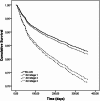Comorbidities, acute kidney injury and long-term mortality in elderly patients hospitalized because of hip fracture: a moderation analysis
- PMID: 38811522
- PMCID: PMC11136753
- DOI: 10.1007/s40520-024-02771-1
Comorbidities, acute kidney injury and long-term mortality in elderly patients hospitalized because of hip fracture: a moderation analysis
Abstract
Introduction: Femoral fractures in elderly individuals present significant health challenges, often leading to increased morbidity and mortality. Acute kidney injury (AKI) during hospitalization further complicates outcomes, yet the interaction between AKI severity and comorbidities, as quantified by the Charlson Comorbidity Index (CCI), remains poorly understood in this population. This study aimed to assess the associations between AKI severity and the CCI and between AKI severity and one-year mortality postfemoral fracture in elderly patients.
Methodology: This study utilized data from the Multiparameter Intelligent Monitoring in Intensive Care (MIMIC-IV) database and focused on elderly patients (> 65 years) admitted with hip fractures. Patients were categorized based on AKI stage according to the KDIGO criteria and CCI scores. The primary outcome assessed was all-cause mortality one year after hospital discharge. The statistical analyses included logistic regression, Cox proportional hazards regression and moderation analysis with the Johnson-Neyman technique to evaluate associations between AKI and long-term mortality and between the CCI and long-term mortality.
Results: The analysis included 1,955 patients and revealed that severe AKI (stages 2 and 3) was independently associated with increased one-year mortality. Notably, the CCI moderated these associations significantly. A lower CCI score was significantly correlated with greater mortality in patients with severe AKI. The impact of severe AKI was greater for those with a CCI as low as 3, more than doubling the observed one-year mortality rate. In contrast, higher CCI scores (≥8) did not significantly impact mortality. Sensitivity analyses supported these findings, underscoring the robustness of the observed associations.
Conclusion: This study elucidates the complex interplay between AKI severity and comorbidities and long-term mortality in elderly hip fracture patients. These findings underscore the importance of considering both AKI severity and comorbidity burden in prognostic assessments and intervention strategies for this vulnerable population. Targeted interventions tailored to individual risk profiles may help mitigate the impact of AKI on mortality outcomes, ultimately improving patient care and outcomes. Further research is warranted to explore the underlying mechanisms involved and refine risk stratification approaches in this population.
Keywords: Acute kidney injury; Hip fracture; Mortality.
© 2024. The Author(s).
Conflict of interest statement
The authors declare no competing interests.
Figures




Similar articles
-
The Charlson and Elixhauser Scores Outperform the American Society of Anesthesiologists Score in Assessing 1-year Mortality Risk After Hip Fracture Surgery.Clin Orthop Relat Res. 2021 Sep 1;479(9):1970-1979. doi: 10.1097/CORR.0000000000001772. Clin Orthop Relat Res. 2021. PMID: 33930000 Free PMC article.
-
Comparison of the Charlson Comorbidity Index with the ASA score for predicting 12-month mortality in acute hip fracture.Injury. 2020 Apr;51(4):1004-1010. doi: 10.1016/j.injury.2020.02.074. Epub 2020 Feb 24. Injury. 2020. PMID: 32151423
-
The risk-adjusted Charlson comorbidity index as a new predictor of one-year mortality rate in elderly Chinese patients who underwent hip fracture surgery.Orthop Traumatol Surg Res. 2021 May;107(3):102860. doi: 10.1016/j.otsr.2021.102860. Epub 2021 Feb 17. Orthop Traumatol Surg Res. 2021. PMID: 33609760
-
Incidence of acute kidney injury-associated mortality in hospitalized children: a systematic review and meta-analysis.BMC Nephrol. 2025 Mar 5;26(1):117. doi: 10.1186/s12882-025-04033-2. BMC Nephrol. 2025. PMID: 40045255 Free PMC article.
-
Charlson comorbidity index and a composite of poor outcomes in COVID-19 patients: A systematic review and meta-analysis.Diabetes Metab Syndr. 2020 Nov-Dec;14(6):2103-2109. doi: 10.1016/j.dsx.2020.10.022. Epub 2020 Oct 28. Diabetes Metab Syndr. 2020. PMID: 33161221 Free PMC article.
Cited by
-
The incidence and influencing factors of postoperative acute kidney injury in elderly patients with hip fractures: A meta-analyses.PLoS One. 2025 Jun 20;20(6):e0322228. doi: 10.1371/journal.pone.0322228. eCollection 2025. PLoS One. 2025. PMID: 40540489 Free PMC article.
-
Correlation between Charlson comorbidity index and surgical prognosis in elderly patients with femoral neck fractures: a retrospective study.BMC Musculoskelet Disord. 2024 Aug 29;25(1):678. doi: 10.1186/s12891-024-07814-2. BMC Musculoskelet Disord. 2024. PMID: 39210355 Free PMC article.
-
Impact of Comorbidities on the Prevalence and Recovery Outcomes in Elderly Patients With Neck of Femur Fractures.Cureus. 2025 May 20;17(5):e84502. doi: 10.7759/cureus.84502. eCollection 2025 May. Cureus. 2025. PMID: 40405903 Free PMC article.
References
-
- Porter CJ, Moppett IK, Juurlink I, Nightingale J, Moran CG, Devonald MAJ. Acute and chronic kidney disease in elderly patients with hip fracture: prevalence, risk factors and outcome with development and validation of a risk prediction model for acute kidney injury. BMC Nephrol. 2017;18(1):20. doi: 10.1186/s12882-017-0437-5. - DOI - PMC - PubMed
MeSH terms
LinkOut - more resources
Full Text Sources
Medical

